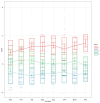Feeling the World Differently: Sensory and Emotional Profiles in Preschool Neurodevelopmental Disorders
- PMID: 40723151
- PMCID: PMC12293204
- DOI: 10.3390/children12070958
Feeling the World Differently: Sensory and Emotional Profiles in Preschool Neurodevelopmental Disorders
Abstract
Background/objectives: Atypical sensory processing is increasingly recognized as a transdiagnostic dimension of neurodevelopmental disorders (NDDs), with critical implications for emotional and behavioral regulation. This study aimed to identify distinct sensory profiles in preschool children with NDDs and to examine their associations with emotional-behavioral and cognitive/developmental functioning.
Methods: A total of 263 children (aged 21-71 months) diagnosed with autism spectrum disorder (ASD), language disorder (LD), or other NDDs (ONDD) were recruited. Sensory processing was assessed using the SPM-P, emotional-behavioral functioning was assessed via the CBCL 1½-5, and cognitive/developmental levels were assessed through standardized instruments. Latent profile analysis (LPA) was conducted to identify sensory subtypes. Group comparisons and multinomial logistic regression were used to examine profile characteristics and predictors of profile membership.
Results: Three sensory profiles emerged: (1) Multisystemic Sensory Dysfunction (20.1%), characterized by pervasive sensory and emotional difficulties, primarily observed in ASD; (2) Typical Sensory Processing (44.9%), showing normative sensory and emotional functioning, predominantly LD; and (3) Mixed Subclinical Sensory Processing (35%), with subclinical-range scores across multiple sensory and emotional domains, spanning all diagnoses. Higher cognitive functioning and fewer internalizing symptoms significantly predicted membership in the typical profile. A gradient of symptom severity was observed across profiles, with the Multisystemic group showing the most pronounced emotional-behavioral impairments.
Conclusions: Distinct sensory-emotional phenotypes were identified across diagnostic categories, supporting a dimensional model of neurodevelopment. Sensory profiles were strongly associated with emotional functioning, independently of diagnostic status. Early sensory assessment may therefore offer clinically meaningful insights into emotional vulnerability and inform targeted interventions in preschool populations with NDDs.
Keywords: autism spectrum disorder; emotional–behavioral functioning; latent profile analysis; neurodevelopmental disorders; preschool children; sensory processing; transdiagnostic approach.
Conflict of interest statement
The authors declare no conflicts of interest.
Figures
Similar articles
-
Parent-mediated early intervention for young children with autism spectrum disorders (ASD).Cochrane Database Syst Rev. 2013 Apr 30;2013(4):CD009774. doi: 10.1002/14651858.CD009774.pub2. Cochrane Database Syst Rev. 2013. PMID: 23633377 Free PMC article.
-
Overall prognosis of preschool autism spectrum disorder diagnoses.Cochrane Database Syst Rev. 2022 Sep 28;9(9):CD012749. doi: 10.1002/14651858.CD012749.pub2. Cochrane Database Syst Rev. 2022. PMID: 36169177 Free PMC article.
-
Early intensive behavioral intervention (EIBI) for young children with autism spectrum disorders (ASD).Cochrane Database Syst Rev. 2018 May 9;5(5):CD009260. doi: 10.1002/14651858.CD009260.pub3. Cochrane Database Syst Rev. 2018. PMID: 29742275 Free PMC article.
-
Atypical antipsychotics for disruptive behaviour disorders in children and youths.Cochrane Database Syst Rev. 2017 Aug 9;8(8):CD008559. doi: 10.1002/14651858.CD008559.pub3. Cochrane Database Syst Rev. 2017. PMID: 28791693 Free PMC article.
-
Falls prevention interventions for community-dwelling older adults: systematic review and meta-analysis of benefits, harms, and patient values and preferences.Syst Rev. 2024 Nov 26;13(1):289. doi: 10.1186/s13643-024-02681-3. Syst Rev. 2024. PMID: 39593159 Free PMC article.
References
LinkOut - more resources
Full Text Sources
Research Materials
Miscellaneous


